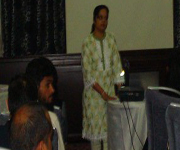The last three years were very much dynamics because of the fortified events of developments going on in the retail sector in India. Startups were getting huge funding and at the same time, Investors were enjoying the curry. Investors' big love remain with the tech startups and were ready to burn the money like crazy.
But now the scenario is changed. There is a list of eB2B players who raised billions of dollars during the last 3 years. Most of them become unicorns. Expanded to other cities like crazy. Some of them infused millions of dollars in setting up distribution centers, employing a big army of manpower, burning millions on marketing, and building up losses. Retailers were in the middle of every eB2B startup.
In this movement, more than a hundred startups are working in bits & pieces in their territories but few of them could succeed to play at the national level. If I count on fingers only three or four startups are working very closely in Grocery retail. Some of them are working in 28 locations i.e. states including 200 cities and more than 10000 pin codes, and some are working in one or two states but all have the same set of problems that they are encountering in their daily operations.
I will not mention the names of those startups working closely in eB2B grocery retail but yes you will understand who will be all about. First of all, I will try to explain the need for eB2B players in this ecosystem of grocery retail and will discuss why they are not able to provide the so-called solutions.
The emergence of Technology: Till 2012 speed of the internet was paced mildly by the broadband connections and had limitations of reach to many tiers 2 and tiers 3 cities. We can't say that e-commerce was not there at that time. Most of the B2B players were using web applications so they were sticking to their seats only and thus could not find it more aggressive. Startups like Indiamart, TradeInida, and many other e-commerce players were the pioneer of their time. Still, Indiamart is doing good. It is all about the vision of Promoters. Transactions started taking place with the availability of Chinese smartphones in the Indian market. Retailers and consumers started using the best features of these phones. Marketplace models like Amazon and Flipkart started onboarding sellers on their platforms. end Consumers started ordering merchandise through Mobile Applications. This has given a big momentum to the B2B players and they started focusing on technology. A fever of investment cartels started coming to India from Silicon Valley from 2013 onwards. VC i.e. Venture Capital funds cartel employing IIM Alumni as their fund manager and they started collaborating with Technocrats. A kind of lobby was built, however, it is not that true as the founders of Oyo, and Paytm were not from that background but yes 70-80% of startups and investors are from top B-schools. Last week I met a former founder of Payment QR fintech. He said that if you are not from IIT or IIM or from Oxford or a top funding company you will not get funding. It is sure that 99% of the chance is that you will not be entertained by investors. This is a big cartel of like-minded people. and like-minded is all about being from the same community. But, my mindset was not to take it with me so why should it happen. I am a businessman carrying a business mindset and I know how to run a profitable business so I know about it. How fresher who came from IIT or IIM know about business sense. But, I can't discuss this here as it is a different matter and thought.
Startups started working on Ideas and started disrupting the existing markets. There was only one feature that was working at that time - Technology led startup or Tech Driven founded by the IIT-ians or technocrats. The focus was given to the Retail sector keeping in mind the size of the market and opportunities. The thought behind eB2B commerce was to disrupt the market through direct reach to the retailers and that had happened only by way of eliminating the middlemen. But, what made them start these business models in India. Let's work on this.
Why eB2B players entering Grocery Retail
Indian retail market is huge in size. GDP of the entire African countries included with many European countries is equal to the Indian Retail market size. A market of USD 800 billion itself a huge amount to count and out of which 60 % market is grocery retail. As per the market sources, this size will be more than USD1.3 trillion by 2030 or more. More than 14 million retailers represent the market. Indian retail mainly in FMCG is channelized by a robust distribution system. More than 35000 distributors are working in FMCG & Grocery sector carrying brands of more than 5000+ manufacturers. The traditional system of distribution was carrying the middlemen like CFA, Super stockiest, Distributors, and wholesalers. The retailers were their customers. Indian traditional distribution system is robust and it got these wings after years of hard work and innovations. FMCG companies like HUL, P&G, Dabur, Nestle, and many more have robust distribution systems.
Now, startups started working on this segment by way of creating efficiencies. What were those efficiencies?
- Reaching Direct to Retailers
- Eliminating middle man
- Technology-driven - Mobile Application in the hand of retailers & their FOS.
- Data Analytics
They found that retailers are facing various issues like dealing with multiple distributors, uncompetitiveness, price discovery, ease of reordering, not getting the benefit of bulk buying, and Not getting proper credit in managing vendor Payments, expiry, and space almost they find that retailers need to be empowered in a way of giving them centralized supply solutions. This is the problem they are facing in a big way. Providing Centralise Supply to Retailers is the solution and giving Sellers/ Brands a one-stop distribution solution that they don't need to go behind traditional distributors. This way brands can save money, time, and energy working. As such, there is no issue in the business model. Technology is giving wings to it and everyone can manage their stuff. This way their target customer is Retailers.
Year 2017 onward we have seen many big names in eB2B, some of them started working as marketplace models, some started as standalone direct-to-retail models, and others started on hybrid models. Few of them were category masters. At the time of their investment pitch, they said their technology-driven business model always remains Asset light. But, later on, eB2B players started working on Asset heavy model i.e. setting up distribution centers in metro cities. I have seen that few have a DC capacity of 3 lakh sq feet in one location, they started employing thousands of salespersons to drive their DTR sales to retailers. Huge infrastructures were built in the name of the Asset Light model. I would say that investors have no idea about the business they just bet on the business model and they do believe in technology-driven models and burning. I am taking readers to the actual scenario which is the backbone of any company working for a profit. following calculations will give some light on the factual status of business these eb2b players are doing.
We can understand this through an example: This study was done taking one eB2B model in the center of my study. I was closely watching the whole operations of an eB2B marketplace startup. They started their business in 2017 and later on after receiving huge funding they moved to other cities very aggressively. An average 50000 sq feet distribution center facility is built up in one city and today they have more than 40 cities where they have physical warehouses/ DC. Setting up their own DC has a different cost and taking them with 3PL has another cost as some go fixed and others go variables.
Let's have tentative figures: I will try to explain them through the below-mentioned table.
(Capex taken higher side, which includes verticals shelves, Pallet Trucks, etc)
The above calculation will give a visual clarification that why eB2B players are not making money. This calculation I have worked out for one location i.e. One city like Delhi or Indore or Jaipur.
If you talk to them you will find that they are working on 11% -15% opex cost/revenue and in return generating GP 3% to 6% if we take benefit of business growth.
Now, Let's bring some light on critical things which are hampering their growth as well as profitability.
The problem faced by eB2B Players
eB2B startups have huge coverage, they have thousands of retailers on-boarded on their Applications, also thousand of Feet on the Street ( FOS) visit retailers daily. They have competitive pricing, availability, and convenience in providing timely deliveries but still, they are not making money. Why?
Every eB2B startups claim to have millions of Retailers on their Application, having a presence across 10000+pincode, and for attracting investors, they are dividing States into Cities so that they can show their milestone in a larger prospect. But again what is wrong with their financials. Few challenges are there which is choking their bottom line irrespective of having million-dollar top-line numbers. Let's put a light there:
- High Operating Cost
- Product Mix Issue
- Restrictive Behaviour of FMCG companies
- No Credit Facility to Retailer.
High Operating Cost: eB2B startups or any startups who want to scale their business, need to go with the system and process. And when any organization goes with the system and process there is always a cost associated with it. Proper functional departments must be in place which in turn stamps with a heavy cost. However, operating cost is a business element and business has to leverage it but due to the improper projections, they are employing manpower in a big way and paying them high salaries. cost of retaining every employee is high as has to give other benefits too and also infra cost is too high. Most of the infra is managed by 3PL but is not able to use full capacity. Only 40-50% capacity is being used but fixed cost is there to make it high operating too. The cost of delivery is too high as MOQ is not adhered to by the retailers. In the above calculation, I have taken 50/- per order selling & distribution cost which is too low but again they are not getting sales to the MOQ.
Product mix issue: No doubt they have sitting on a very high operating cost. However, it can be covered if revenue to the tune is generated but again improper product mix is melting the bottom line. If you can analyze the product category mix you will find that retailers are using them only for main staples like Oil, Ghee, Sugar, Pulses, etc which is again a convenient buying to retailers because they are getting everything under one roof. Staples is only contributing to the top line so having up to 80% contribution in their revenue, but if you go by the gross margin level you will find that staples in bulk or in a popular demanded brand are very thin. like Oil and Ghee for a popular brand, no one can earn more than 2% except for market volatility. The same is with Sugar and Pulses. Majorly traded in bulk packaging. If one has 70-80% contribution of Oil & Sugar in their revenue then you can imagine the bottom line. Apart from this 2% is the RTV cost including the in-transit damage to the merchandise.
Restrictive behavior of FMCG companies: Since FMCG companies have a robust traditional channel in place so their FMCG brands do not want to disturb the GT market for these players, however, they want to sell on eB2B but they never compromise on pricing. In one incident, Parle company fought a case with one B2B startup and denied giving them their products. It is their helplessness to buy at their Price and then through a discount from their end, they sell on their platform. demanded product is the requirement of these startups because there is something needed that shows engagement with retailers otherwise, retailers will not entertain or will use its limits. They need FMCG national-level brands so that Retailers give space to salesman to stay at their counter and can cross-sell other merchandise. How they will sell new brands having high margins or can build a healthy category mix. You can see the contribution of such products.
Credit to Retailers: Since startups are working on systems and processes and they are more dependent on technology-driven stuff so they have limitations somewhere. May be from the business model side as they got funding on it and they can't let open the credit in the market. All are selling their stuff against COD or through some fintech arrangement like channel funding. But, it is true that Retailers will not buy any products except demanding one against cash. Even FMCG distributors are providing credits to retailers. Local Mandies especially for staples are providing 5-15 days of credit to retailers. Retailers are buying stuff from eB2B players. This is one big factor that they will not be able to generate more revenue from retailers without giving open credit. Open credit means based on trust. Like local distributor and mandi traders has for them.
Above are the pinch of problems I tried to figure out. But, I have a concern that without disturbing the existing distribution system startups from eB2B will not scale their business but they will not make money. For making money they have to work on a different scenario. Still, they will remain eB2B but few things will be aligned otherwise they will never make money.
Last year remain investor dry weather in India. They understood the fact that burning will not bring earnings even in the long run. Retail will only use these eB2B platforms for their best selfishness but never contribute to scale. Disturbing the existing ecosystem is a costly affair for them and if they don't take them with their journey, they will be finished mid-way.
eB2B startups have to adapt a few things which will help them to sustain themselves. My best advice for them is to pivot the business model in the right direction and don't think to disturb the existing channels. If possible think about how you can associate with them and take them on your journey.
I am working on this, creating a scalable and profitable business model.

















